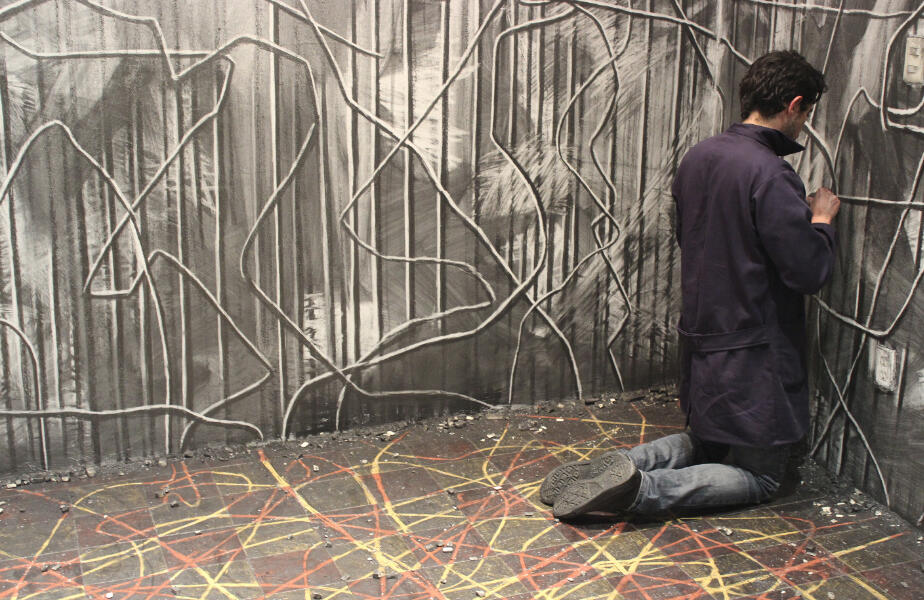_Ocupación_ by Mauro Giaconi at Casa Vecina in Mexico City
The Argentinian artist who lives in Mexico City realized the intervention Ocupación, in response to the program Fuera de sala, which invites young contemporary artists to intervene in the space of the reading room adjacent to the Documentation Center in Casa Vecina in Mexico City.

We reproduce here the text with which the contemporary art curator and artistic education projects director, Violeta Celis, added to her intervention.
“Giaconi's work moves between the field of sculpture and installation, drawing being the field of production from where he generates provocative spaces where chaos gains spectacular dimensions.
Working in architectural spaces brings Giaconi the opportunity to reflect on some of his principal philosophical interests and artistic investigations: the physical and mental confinement that entails a continuum of permanent vigilance, a concept which continuously contrasts that of 'liberty'. The tension generated between opposing concepts or ideas has led him to explore the limit situation addressing aspects like memory, body, tangible and intangible frontiers, and politics.
He comes from a generation that had to create diverse devices to assimilate to the Argentinian dictatorship. Giaconi recovers a great part of these tacit languages that the citizens kept between themselves in order to survive repression and violence. From this place he conceives his practice as a possibility to recover his memory and — why not?— to heal it. It is then that the aesthetic of chaos predominant in a great part of his graphic work is inverted and surges as the instance from which spectators can find a place of relief and redemption.
His new intervention, Volver, should also be highlighted. It will be touring in the wings of the Museo Palacio de Bellas Artes, as part of the Panoramic-landscape 1969-2013 exhibition. For this occasion, the artist parted from the etymological definition of the word "revolution" to generate dialogues with space, history, and with the architectural decoration of the place.
Giaconi conceives the gesture of his drawings as an almost repetitive exercise, which gives off an energy quasi-similar to a mantra, sacred and freeing. In this sense, the energy accumulated during the graphic "occupation' of the artist in the space permitted him to reunite the four actors that committed, in two separate occasions, the act of drawing with graphite as they simultaneously erased the walls charged with the same material. Each one dressed with a work apron similar to the one artists use in their studio, they took out from their pockets graphite, erasers, and cutters to engraving, squatting or walking from one wall to the other to the window that looks out into Regina street. As if through the collective repetition that occurred for two hours in each exhibition, there has been a kind of corporal meditation created that breached the limits of individual convention of the artist, enabling him or her to be in another territory that had been, until now, unknown to them. It is important to mention that Ocupación is the first intervention planned by Giaconi, thus, there is space to reflect on how space itself provoked the displacement of his creative process to other protagonists and another language of artistic production.
From this perspective, the project parts from the redefinition that the artist himself makes of the action of physically 'occupying' a place, understanding it even as a political attitude of resistance. It is in this way that the impossibility of confinement imposes itself in prisons, cells, or cages through the walls, glasses, doors, and floor of the reading room saturated-erased with graphite. In which the "occupants' did the same action: draw, erase, fill with graphite again and again in a completely contradictory action, leaving a footprint and at the same time erasing it, like a Ritornello that will not take them anywhere.
Reinterpreting in a way the same disposition of the prisoner, who leaves their footprint in their cell as he dreams incessantly of making it disappear through the daily gaze, as the prisoner who makes a hole keeping the hope that it will be larger next day. When the action is done we see the "occupants' come out silently from the small room. They leave behind them remains of erasers and graphite scattered on the floor, their hands and faces darkened by the graphite are reminders of their stances and the accumulated energy in the room. They are still concentrated but they are satisfied, they smiled, the reward of the liberation that has come”.






